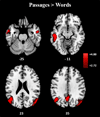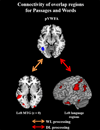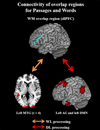Comprehending text versus reading words in young readers with varying reading ability: distinct patterns of functional connectivity from common processing hubs
- PMID: 27147257
- PMCID: PMC4945471
- DOI: 10.1111/desc.12422
Comprehending text versus reading words in young readers with varying reading ability: distinct patterns of functional connectivity from common processing hubs
Abstract
Skilled reading depends on recognizing words efficiently in isolation (word-level processing; WL) and extracting meaning from text (discourse-level processing; DL); deficiencies in either result in poor reading. FMRI has revealed consistent overlapping networks in word and passage reading, as well as unique regions for DL processing; however, less is known about how WL and DL processes interact. Here we examined functional connectivity from seed regions derived from where BOLD signal overlapped during word and passage reading in 38 adolescents ranging in reading ability, hypothesizing that even though certain regions support word- and higher-level language, connectivity patterns from overlapping regions would be task modulated. Results indeed revealed that the left-lateralized semantic and working memory (WM) seed regions showed task-dependent functional connectivity patterns: during DL processes, semantic and WM nodes all correlated with the left angular gyrus, a region implicated in semantic memory/coherence building. In contrast, during WL, these nodes coordinated with a traditional WL area (left occipitotemporal region). In addition, these WL and DL findings were modulated by decoding and comprehension abilities, respectively, with poorer abilities correlating with decreased connectivity. Findings indicate that key regions may uniquely contribute to multiple levels of reading; we speculate that these connectivity patterns may be especially salient for reading outcomes and intervention response.
© 2016 John Wiley & Sons Ltd.
Figures










References
-
- Amunts K, Zilles K. Architecture and organizational principles of Broca’s region. Trends in Cognitive Sciences. 2012;16(8):418–426. http://doi.org/10.1016/j.tics.2012.06.005. - DOI - PubMed
-
- Baretta L, Tomitch LMB, MacNair N, Lim VK, Waldie KE. Inference making while reading narrative and expository texts: An ERP study. Psychology & Neuroscience. 2009;2(2):137–145.
-
- Berman RA, Nir-sagiv B. Comparing Narrative and Expository Text Construction Across Adolescence: A Developmental Paradox. 2007 Retrieved from http://www.tandfonline.com/doi/full/10.1080/01638530709336894#tabModule. - DOI
-
- Binder JR, Desai RH, Graves WW, Conant LL. Where is the semantic system? A critical review and meta-analysis of 120 functional neuroimaging studies. Cerebral Cortex (New York, N.Y.?: 1991) 2009;19(12):2767–2796. http://doi.org/10.1093/cercor/bhp055. - DOI - PMC - PubMed
Publication types
MeSH terms
Grants and funding
LinkOut - more resources
Full Text Sources
Other Literature Sources

